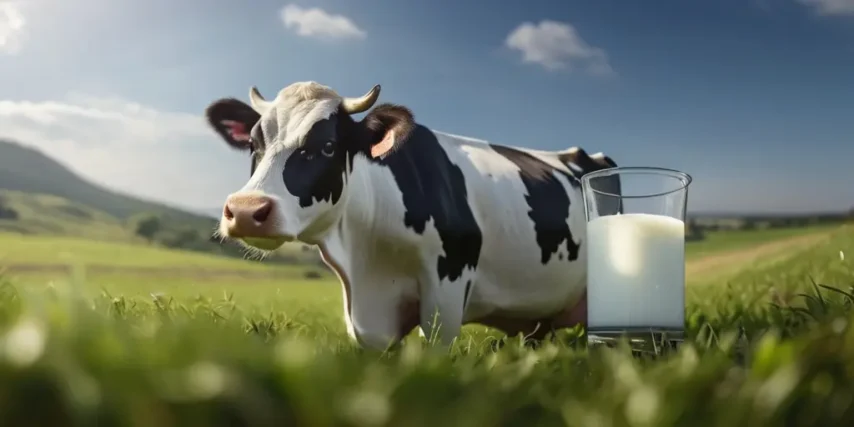The Marvels of Bovine Biology: Decoding the Intricate Process of Milk Production in Cows
Introductio
Milk, often regarded as nature’s perfect food, has been a staple in the human diet for centuries. While it’s readily available in supermarkets, few of us pause to contemplate the fascinating journey it takes before reaching our tables. In this exploration, we delve into the intricate process by which cows, specifically dairy cows, produce milk – a marvel of bovine biology that involves a harmonious interplay of physiology, nutrition, and environmental factors.
- Bovine Mammary Glands: Nature’s Milk Factories
At the heart of milk production in cows lies the remarkable bovine mammary gland. Essentially, these glands function as nature’s own milk factories. Like humans, cows possess mammary glands arranged in pairs, positioned beneath the skin of the udder. The udder is a specialized organ designed for the production and storage of milk.

- The Role of Hormones: Orchestrating the Symphony of Milk Synthesis
The initiation and regulation of milk production are orchestrated by a complex interplay of hormones. The key players in this symphony are prolactin and oxytocin. Prolactin, produced by the pituitary gland, stimulates the mammary glands to start milk synthesis, while oxytocin triggers the release of milk during milking. This hormonal dance is finely tuned to the cow’s reproductive and lactation cycles.
- Lactation: A Dynamic Cycle
Lactation is the physiological process of producing and secreting milk. Dairy cows typically experience a cycle of lactation that begins after giving birth. This cycle involves several stages, including the dry period, parturition, the onset of lactation, peak milk production, and the decline in milk yield as lactation progresses. Each stage is crucial to the overall efficiency of milk production.
- Nutrition: The Cornerstone of Milk Quality and Quantity
A cow’s diet plays a pivotal role in the quality and quantity of milk produced. Adequate nutrition is essential to support the high metabolic demands of lactation. Dairy farmers carefully formulate balanced diets, ensuring the right mix of energy, protein, vitamins, and minerals. This attention to nutrition not only influences the cow’s health but also impacts the composition of the milk, including the levels of fat, protein, and essential nutrients.

- The Daily Milking Routine: A Farmer’s Precision Dance
Dairy farming is a delicate art that requires precision and care. The daily milking routine is a critical aspect of milk production. Modern dairy farms often employ advanced milking technologies, including automated milking systems, to enhance efficiency. The process involves cleaning the udder, attaching milking machines, and ensuring a stress-free environment for the cows – all factors that contribute to optimal milk yield.
- Environmental Factors: Comfortable Cows, Quality Milk
Cows are highly sensitive to their environment, and their comfort directly influences milk production. Adequate shelter, proper ventilation, and comfortable resting areas are essential for maintaining the well-being of dairy cows. Stressors such as extreme temperatures, noise, and overcrowding can negatively impact milk yield and quality. Therefore, maintaining an optimal and stress-free environment is crucial for successful dairy farming.
- Genetics: The Blueprint for Productive Cows
The genetics of a dairy cow significantly influence its milk-producing potential. Through selective breeding, farmers aim to enhance desirable traits such as milk yield, composition, and overall health. Advances in genetic technologies allow for more precise selection, ultimately contributing to the development of high-performing dairy herds.

- Challenges in Milk Production: Addressing Health and Welfare
Milk production is not without its challenges. Dairy farmers must constantly monitor the health and welfare of their cows to ensure a sustainable and ethical approach to farming. Common challenges include mastitis, a bacterial infection of the udder, which can impact milk quality and cow well-being. Sustainable and ethical practices, including responsible antibiotic use and humane treatment, are essential components of modern dairy farming.
- Technological Innovations: Shaping the Future of Dairy Farming
The world of dairy farming is continually evolving, driven by technological innovations. From precision farming and smart sensors to robotics and genetic engineering, advancements in technology are reshaping the landscape of milk production. These innovations not only enhance efficiency but also contribute to the sustainability of dairy farming practices.
In unraveling the mysteries behind how cows produce milk, we gain a profound appreciation for the complexity and sophistication of nature’s design. From the orchestration of hormones to the careful balance of nutrition and the influence of genetics, milk production in cows is a multifaceted process. The dedication of dairy farmers, coupled with advancements in science and technology, ensures a steady supply of high-quality milk for our tables. As we raise our glasses to toast the wonders of dairy, let us not forget the silent heroes – the dairy cows – whose extraordinary biology makes it all possible.







